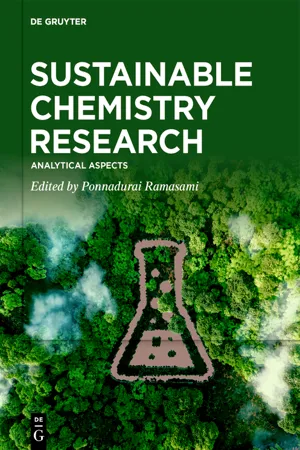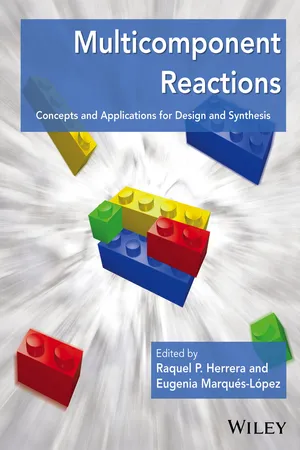Chemistry
Strecker Synthesis
Strecker Synthesis is a chemical reaction that produces amino acids from aldehydes or ketones. The reaction involves the addition of hydrogen cyanide to the carbonyl group of the aldehyde or ketone, followed by hydrolysis of the resulting nitrile to form an amino acid. This process is widely used in the production of amino acids for use in the food and pharmaceutical industries.
Written by Perlego with AI-assistance
Related key terms
3 Key excerpts on "Strecker Synthesis"
- eBook - ePub
Sustainable Chemistry Research
Analytical Aspects
- Ponnadurai Ramasami, Ponnadurai Ramasami(Authors)
- 2023(Publication Date)
- De Gruyter(Publisher)
It is very interesting that the ever-historical discovery of the MRCs was recorded by Strecker in 1850 which paved the way to the discovery of other reactions such as Hantzsch, Biginelli and Mannich. The above-mentioned reactions are playing a vital role to date in medicinal chemistry synthesis, natural products preparation, the chemical industry and green chemical production. The IMCR remains one of the important interesting elegant chemistry applied in the construction of important end products. Hence the review presents a unique dual electrophilic/nucleophilic reactivity of the isocyanides-carbon which provides distinct complex products demonstrated by Passerini, Ugi and zwitterion intermediates reactions.2.2 Strecker reaction (S-3CR)
The Strecker reaction [10 ] was first reported in 1850 after condensation of an aldehyde 1.1 with a cyanide source 1.2 in the presence of ammonia 1.3 to give intermediate 1.4 followed by hydrolysis of the nitrile group to form an amino acid 1.5 as shown in Scheme 2.1.1 .Scheme 2.1.1: The Strecker 3-CR (S-3CR).The fact that the Strecker reaction occurs in aqueous medium and under catalyst-free conditions made it one of the favourable methods for application in industries and laboratories because it is a convenient approach to produce amino acids, natural products and bioactive compounds. However another factor to consider is the commercial availability and affordability of the substrates required [28 ], [29 ], [30 ]. To date the Strecker reaction has produced a myriad of publications and is still under ongoing investigation. There are several biologically active compounds produced using the S-3CR [27 ], such as boron-containing retinoids [31 ], hepatitis C virus NS3 serine protease inhibitors [32 ] and (±)-phthalascidin 622 [33 ]. Several methods used for the synthesis of amino acids and bioactive compounds involve the use of catalysts, such as Al-MCM-41 [34 ] and other nanostructured silicates [35 ], nanocrystalline magnesium oxide [36 ], BINOL-phosphoric acid [37 ], N-heterocyclic carbene (NHC)-amidate palladium(II) complex [38 ], gallium (III) triflate [39 ] and bisformamides [40 - eBook - ePub
Comprehensive Enantioselective Organocatalysis
Catalysts, Reactions, and Applications, 3 Volume Set
- Peter I. Dalko, Peter I. Dalko(Authors)
- 2013(Publication Date)
- Wiley-VCH(Publisher)
30 Hydrocyanation and Strecker Reactions Carsten Kramer and Stefan Bräse30.1 Introduction
In 1850, A. Strecker accidently accomplished the first synthesis of the amino acid alanine by mixing of acetaldehyde, ammonia, and HCN and subsequent hydrolysis of the formed adduct [1]. Whereby this three-component-reaction is in general known as the Strecker reaction, the addition of a cyanide source to a preformed imine species is often referred to as the “modified Strecker reaction,” The so-formed α-amino nitriles, or from cyanide addition to carbonyl compounds the so-obtained cyanohydrins, are versatile building blocks that can be converted, for example, into α-hydroxy carbon acids, amino acids, amino alcohols and diamines.30.1.1 Overview
Several catalysts have been developed for the asymmetric organocatalyzed hydrocyanation of carbonyls and for the Strecker reaction. This chapter divides the catalysts into several subgroups, defined according to important structural motifs responsible for catalytic activity. Each catalyst group will be discussed in detail with regard to substrate scope, limitations, and other important factors. In addition, mechanistic insights will be provided, if transition states are satisfyingly revealed by experimental work or in silico studies.30.2 Amino-Acid Containing Catalysts for Carbonyl Hydrocyanation
In 1981, Inoue and coworker accomplished the first organocatalyzed hydrocyanation of benzaldehyde (1) with reasonable asymmetric induction (Scheme 30.1 ) [2]. By using 2 mol% of the cyclic dipeptide cyclo(l -phenylalanine-l -histidine) (2), benzaldehyde (1) reacted with HCN in benzene at 35 °C to give the cyanohydrin 3 - eBook - ePub
Multicomponent Reactions
Concepts and Applications for Design and Synthesis
- Raquel P. Herrera, Eugenia Marqués-López(Authors)
- 2015(Publication Date)
- Wiley(Publisher)
Due to the importance of obtaining α-aminonitriles [50] , which can be subsequently converted in α-amino acids, many efforts have been engaged to the development of catalytic asymmetric approaches [51] and for applying this methodology in the synthesis of many natural products [52] with biological applications. Although metal catalysis has been the preferred tool of choice for the hydrocyanation of imines, in the last years, asymmetric organocatalysis has gained more interest as an attractive and alternative strategy [48c, 53].Amino acids are the basic building blocks of proteins in all living organisms, constituting one of the five most important families of natural products [54] . These compounds have registered a growing demand over the years since they are considered key scaffolds in many scientific areas. Currently, they are mainly requested as optically active compounds, which are used for research as chiral catalysts and as chiral pool in the ligand design and in total synthesis, and numerous are the applications of these substrates. For this reason, the development of new and enantioselective synthesis is a continuous challenge. The importance of this process is also reflected in the work reported by Miller supporting the probable key role of the Strecker reaction in the origin of life under primitive Earth conditions for what Miller used a mimic prebiotic synthesis of amino acids from a mixture of CH4 , NH3 , H2 , and H2 O [55] .Although some interesting reviews have appeared in the last years covering this appealing area of research in the field of organocatalysis [48c, 53] and metal catalysis [48d, 51], we will try to remark in this section the most important examples since 2005.10.2.2 MC Strecker Reaction Using Aldehyde
Although the Strecker reaction has some drawbacks such as the use of highly toxic cyanide derivatives, the use of other milder cyanide sources has been introduced in order to avoid partially this inconvenience. Moreover, instead of the initial aqueous media, this has been changed for other common organic solvents (toluene, methylene chloride, acetonitrile, etc.), improving the solubility of the organic reagents as well as the reaction conditions. In some cases, the methodologies require tedious work-up generating a large amount of waste, or some of the Lewis acids employed are toxic as well as the products resulting from their hydrolysis. Therefore, there is a continuous interest to explore and develop milder, safer, and more efficient protocols for this reaction.
Index pages curate the most relevant extracts from our library of academic textbooks. They’ve been created using an in-house natural language model (NLM), each adding context and meaning to key research topics.


